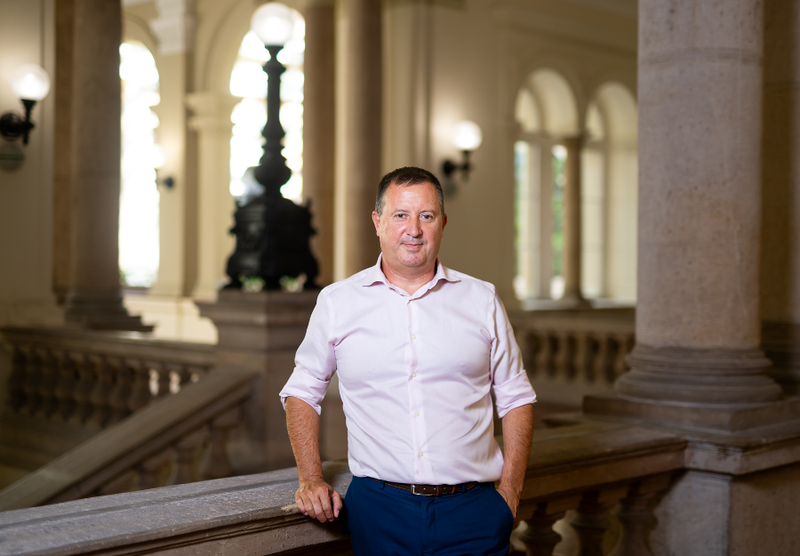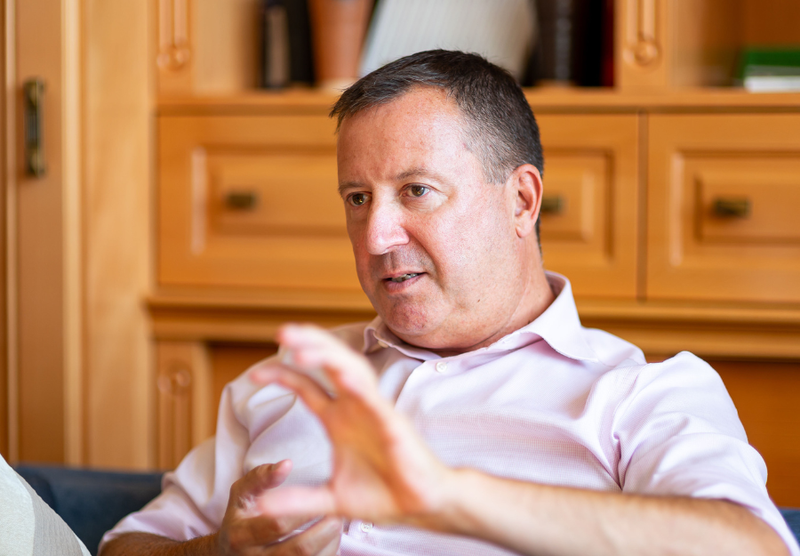“Building Corvinus’s Present to its Future” – Interview with Bruno van Pottelsberghe on the Bridge Strategy
_20251001093121.png)
The past year has been all about renewing the strategy. Looking back, how would you assess this process?
The first step was to restructure the university’s governance structure: we replaced the previous three-member Presidential Committee (President, Rector and Chancellor) with the new Executive Committee. I am jointly responsible for both academic and operational tasks, while the three Vice-Rectors oversee the academic fields and three Directors lead the service areas. I believe this structure fosters close collaboration between the academic and operational communities. Following this, we began reviewing the strategy, as it is essential that every leader can fully identify with the plans and are committed to it.
What were the most important milestones during the fine-tuning process?
First, we launched a bottom-up approach: five working groups were created around the key areas of education, research, student well-being, employee experience, and internationalization. These groups operated autonomously with broad participation from all stakeholders and generated many valuable suggestions, many of which were incorporated into the strategy. At the same time, a top-down approach was also necessary, as some priorities do not naturally emerge from the bottom. Financial considerations were an important part of the process: during the fine-tuning, we paid special attention to clarifying the university’s operational model. From an economic perspective, one of the strategy’s foundations is the student–faculty ratio, which is currently too low and not aligned with the institution’s accessible resources. Therefore, we aim at improving this indicator: switching from a ratio of 17 in 2024 to 25 by 2030.
Why did you choose the name ‘Bridge Strategy’ for the plan?
The new strategy incorporates numerous symbols, starting with its very name. The “bridge” carries multiple meanings: it references the Liberty Bridge next to the Fővám Square building, one of Budapest’s iconic landmarks, while from the perspective of internationalization, it also represents the connection between East and West. Dialogue between parties is always essential, and both Budapest and Corvinus offer excellent opportunities for this. The university itself creates a bridge between the student years and professional life, and the strategy connects Corvinus’s present to its future.

What are the main building blocks of the new strategy?
Our strategy—like a bridge—rests on a solid foundation and significant pillars. The foundation is “operational excellence”, which underlies every area of our activities. Upon it stand four pillars, each of which we have also associated with a symbolic representation.
-
Tram 2: This metaphor emphasizes the importance of a multidisciplinary approach. Tram line 2 connects the university with Budapest’s key districts—places where our students’ career paths may also lead, including the Parliament. However, to succeed in responsible positions, it is not enough for them to be proficient in economics or finance: they also need knowledge of statistics, history, sociology, and even psychology as future leaders. A tram is also one of the most sustainable forms of transport, offering significant opportunities in the field of smart mobility. Similarly, Corvinus strives to build on sustainability and the possibilities offered by artificial intelligence.
-
Flight 6: This symbol highlights the importance of understanding other countries and cultures, to connect with external stakeholders, countries, and companies. It addresses both increasing the number of international students and providing opportunities for our Hungarian students to gain international experience. At the same time, it also expresses our desire to build close ties with the corporate sector and our openness to expanding our academic collaborations internationally.
-
Intercity: It is an affordable form of transportation, available to students in Hungary at a favorable price throughout the year, which is why we chose it as a symbol of student-centeredness. Our goal is to offer students a structured and affordable academic journey, complemented by extracurricular development opportunities and services that support their mental well-being.
-
Ring: The symbol refers to the ring held in the raven’s beak in the university’s logo. The black raven holding the ring was the heraldic animal of King Matthias, who became famous, among other things, for establishing one of Renaissance Europe’s most significant libraries, the Bibliotheca Corviniana, after which our university is named. This emblem expresses that we aim not only to excel in the transmission of knowledge but also in the creation of new knowledge through research. Our goal is to become internationally recognised as a knowledge generating institution.
Along the four pillars of the Bridge Strategy we have selected 100 projects to be implemented over the next three years. In addition to our objectives, the strategy also sets out the university’s redefined mission, vision, and values, which we developed with the involvement of the university community.
|
What are the most important innovations in the Bridge Strategy?
The teaching loads of our academic staff can vary significantly today. Our goal is that those who currently focus primarily on teaching will teach slightly less and take on a greater role in knowledge creation, for example, through books, case studies, and other publications. Conversely, those who focus mainly on research should become more actively involved in teaching. For internationalization, we aim to increase the proportion of international students from 20% to 30% in both undergraduate and master’s programmes, by 2028. We also need to attract world-renowned professors and researchers, targeting a 30% international representation within the faculty. As with student recruitment, knowledge and quality are key in selecting our staff; we want to attract internationally recognized scholars, both Hungarian-born and from abroad. Additionally, in terms of curriculum development, we aim to ensure that sustainability and artificial intelligence gradually play a significant role across all our disciplinary programs, highlighting their impacts and opportunities.

What are the next steps for implementing the strategy?
The document titled Bridge Strategy is now publicly available on both our website and the intranet, and I encourage every member of the university community to familiarize themselves thoroughly with its content. It is important to pay attention to the redefined mission, vision, and values, but it is also worthwhile to review the priority projects. These will be our key tasks over the next three years, and fortunately it is starting very well. This year, we are particularly pleased with our admissions results: we admitted 25% more students than last year, which is also an important achievement in terms of increasing our resources.
What responsibilities await the university’s leaders?
Each member of the Executive Committee has a specific role linked to at least one strategic pillar. During the autumn, they will inform their teams about the key objectives and initiatives. In addition, we held the usual leadership retreat in mid-September, focusing on developing the performance indicators for 2025–2026. We will soon share the new KPIs with colleagues, which will reflect targets directly related to the implementation of the strategy.
What is expected from the university staff regarding the implementation of the strategy?
I truly hope that everyone will find the new strategy inspiring, as anyone working here can contribute to at least one of the pillars or to operational excellence. I believe that the leadership forums and the new KPIs turn strategy into concrete, tangible tasks for everyone. We will regularly provide feedback to the university community on the results achieved and progress made, ensuring that the process is transparent. At present, the new strategy is still in words, symbols and images. Its implementation will require the joint, persistent effort of many colleagues. For this, it is also necessary that we all collectively work, allocate and communicate with each other, and spend time on campus as much as possible.
Previous interviews with members of the Executive Committee: